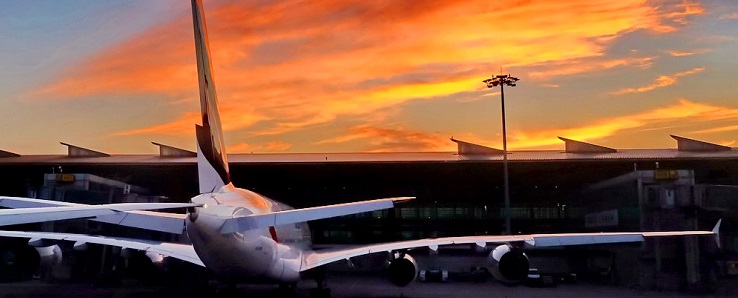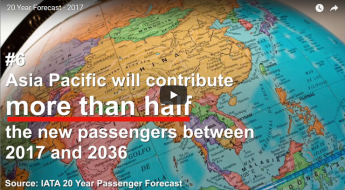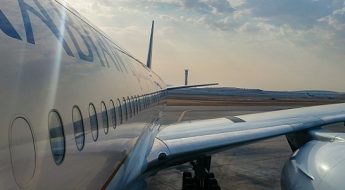
The air transport industry has promoted the idea of seamless travel for many years. IATA’s vision for its current Fast Travel program is that 80% of passengers be offered a complete suite of self-service options based on industry standards. What does this really mean for the passengers? Matthys Serfontein, Vice President, Airport Solutions, SITA, shares facts about Airport IT Trends and thoughts about what seamless travel will really mean for passengers.
The air transport industry has promoted the idea of seamless travel for many years. IATA’s vision for its current Fast Travel program is that 80% of passengers be offered a complete suite of self-service options based on industry standards. What that means for the passenger is a faster and smoother journey. In fact, IATA estimates that for outbound passengers, 10 minutes from curbside through to duty free is possible and is already happening at a number of airports today. The inbound journey is more difficult to predict because at major hub airports the distance from the gate to the baggage carousel can be extensive and border control has to be factored in. However, IATA estimates that 30 minutes for the inbound journey is possible.
Moving closer to seamless travel
The air transport industry has promoted the idea of seamless travel for many years. IATA’s vision for its current Fast Travel program is that 80% of passengers be offered a complete suite of self-service options based on industry standards. What that means for the passenger is a faster and smoother journey. In fact, IATA estimates that for outbound passengers, 10 minutes from curbside through to duty free is possible and is already happening at a number of airports today. The inbound journey is more difficult to predict because at major hub airports the distance from the gate to the baggage carousel can be extensive and border control has to be factored in. However, IATA estimates that 30 minutes for the inbound journey is possible.
This is one thing that passengers and airport operators agree on – get travelers through the travel formalities as quickly and efficiently as possible. It removes the hassle, and therefore stress, for passengers. We know from our passenger research that cutting wait times makes people happier; the reverse is also true. We also know happy passengers are more likely to take advantage of the retail options at the airport, which is good for airport operators and their tenants.
The solution is the smart use of technology. Our role at SITA is to make sure airports and airlines have access to the very best solutions. We research emerging technologies such as the Internet of Things, cognitive computing, blockchain, single travel tokens, beacons, and even wearables. Our aim is to find the best use case to move towards a truly seamless travel experience at airports. That doesn’t mean we ignore older technology. For example, we’ve made RFID baggage tracking available for many years but it is only now coming into its own at airports, largely because the cost of the equipment has reduced. It’s all about the appropriate technology.
What Passengers Want
What exactly do passengers want? The basic answer is to spend as little time as possible getting from the curb to the gate. They want to eliminate the stress of check-in, immigration and security and have more time to enjoy the services, lounges and retail. They are also demanding personalized airport information be put at their fingertips, be it updates on flight delays, gate changes or baggage collection.
Passengers also want more control over their airport journey and are shaping how airports will interact with them in the future. The ‘connected passenger’ has become a reality, with almost everyone carrying at least one personal electronic device when flying. And it is not just mobile devices; smartwatches are also becoming more prevalent. They can receive real-time information and make it easier for passengers to move through the airport. A smartwatch requires just a quick flick of the wrist for a passenger to have all the relevant information. As the number of travel apps optimized for smartphones increases, it will help improve the passenger experience by making it easier to complete the various steps along their journey, whether it is check-in, boarding or clearing immigration by having all their biometric information stored on the device. Wearable devices will increasingly be used at airports over the next three years. SITA’s 2016 Airport IT Trends Survey shows that, by 2019, over a quarter of airports will either have a wearable program or a trial in place.
Airports are also increasingly using beacon technology, in conjunction with mobile apps, to deliver real-time ‘day of travel’ information services directly to passengers at the appropriate point in their journey. By understanding where the passenger is in the airport, beacons can efficiently guide them with
directions or walk times to gates, for example, or display their mobile boarding pass as they approach the gate. The Airport IT Trends Survey shows a quarter of airports have already implemented sensor technologies, up seven per cent on the previous year: this is happening fast.
Leading the way are airports such as Miami International Airport. It’s app, launched last year, was the first in the USA to use the latest technologies, including Bluetooth beacons, to get the right information to the right people, when and where they need it. The app presents an easy-to-use interface and gives travelers personalized updates, directions and tips based on their location and needs.
As travelers make their way through the airport, the app provides information and support that is relevant to their individual journey, including updates on their gate, flight times and baggage collection, as well as nearby food and retail outlets, prioritizing suggestions based on their current location. The app beautifully presents the most accurate and up-to-date indoor maps. And with ‘blue-dot’ functionality, map rotation, turn-by-turn directions, ‘walk times’ and a ‘near me’ feature, they allow passengers to quickly locate virtually anything inside the airport.
Using big data
The advent of cognitive computing, led by IBM Watson, has the potential to unlock an even deeper level of personalization. Using natural language processing and machine learning, IBM Watson can reveal insights, patterns and relationships from the huge amount of data held by airlines, airports and passengers themselves. It is able to answer complex questions and interpret data to provide contextual and relevant answers.
By sharing this data and integrating passenger information, cognitive computing can make sense of all the data available to provide passengers travel information and recommendations, even beyond the airport. Many passengers, Millennials in particular, are more than willing to share their personal data if they see that they can get some benefit in terms of information or a value-added service.
One of the most promising applications is the potential to use cognitive computing as a CRM tool. Imagine if a passenger has a specific problem and reaches out to the airport using twitter or email? Using cognitive systems, the airport can have a live but automated conversation with the passenger to resolve their issue on the go and in real-time.
Connecting Everything and Everything Connected
From an airport operation point of view, the emergence of the Internet of Things is proving to be key to anticipating issues along the journey before they result in a delay. The ability to receive information from objects across the airport operations, from baggage, passenger flow or aircraft departures helps provide a real-time overview of the airport.
For airports, this business intelligence allows them to proactively respond to changes in the airport and ensure the flow is as smooth as possible, with the added benefit of being able to keep passengers up-to-date every step of their journey. The use of business intelligence tools such as SITA’s QueueAnalyzer, which monitors and predicts queue-times at key airport touchpoints, allows airport operators to proactively allocate resources and staff to improve operational efficiency and the passenger experience.
A Single Travel Token
However, it is the emergence of the single travel token that is perhaps the most exciting development for passengers hoping to fast-track through the airport. This is the future of air travel, where we can really begin to provide a walkthrough experience, from check-in to the aircraft door. By capturing passengers’ biometrics and travel information into a single digital record on their own phone, travelers will be able to use this token as identification at each step along their journey. It will also provide the ability to combine some travel steps into a single interaction, vastly speeding up the time needed to complete these formalities.
The technology allows a passenger’s biometric details to be captured through a facial scan at the first touch point in the journey. The biometric record is checked against the passenger’s travel documents and a secure single token is created. Then, at every additional step in the journey – whether it is during self-bag drop, at border control or aircraft boarding – passengers simply complete a facial scan without having to provide their passport or boarding card.
The key to single token travel is gathering and verifying data as early in the process as possible in order to establish a robust token. This includes both biometric and biographic information. And then, if necessary, to update it with more detailed information at various steps in the journey. We call it SITA Smart Path™. A key advantage of this technology is the ability to use and integrate with existing airport infrastructure – including industry standard common-use, self-service equipment such as our Airport Self-Service Gates and Automated Border Control (ABC) Gates – making rapid deployment easy and cost-effective. Smart Path also integrates with government systems and databases, providing a full picture of each passenger. Looking further into the future, we can see that ultimately passengers could have a single identity token permanently and securely stored on their phone which would be simply swiped at each step of the way, at any airport in the world.
We are also examining the use of blockchain as the enabling technology for a single travel token to work across all airports and borders. Blockchain allows ‘privacy by design’ so passenger data can be secure, encrypted, tamper-proof and unusable for any other purpose. At the same time, it eliminates the need for a single authority to own, process or store the data. Our vision is that, no matter where in the world you go, any authority can simply scan your face and scan your device to verify you are an authorized traveler.
It is not difficult to see why airports and airlines would embrace this technology so enthusiastically. It will improve security oversight and elevate the passenger’s travel experience while speeding up passenger processing and reducing the resources needed to manage the travel journey.
There is still a lot of work to be done in agreeing the global standards and security protocols needed to use the mobile application across all airports, but clearly this is the next step.
Airport of the Future
Looking to the future: we’re at the early days of solutions using blockchain and some of these other technologies. But we should expect to hear much more about them, as they develop and mature, over the coming years.
We also expect to see airport staff using wearables more. We trialed the first generation of wearable tech and the potential of the next generation is looking promising. We’ll also see more passenger applications for wearables emerging, again as the technology itself develops and changes.
How about a robot to look after your bags? That might seem futuristic but Leo, our baggage robot, has already been tested at various airports around the world. The robot takes your bags when you arrive at the airport and makes sure they go to the right place. Wide-spread deployment of fleets of Leos is some way off but widespread use of robotics will come to airports in time.
Virtual reality is another technology that can help passengers and airports alike, for wayfinding and to make operations more efficient.
But it’s important to remember the huge impact existing technologies have and not to get too caught up in the excitement of the New. Self-service, for example, has been a round in airports for several years but hasn’t yet reached full maturity. It is one of the driving factors in smoothing the passenger journey. And passengers love it. Our 2016 Passenger Survey showed that people prefer technology to people. Nearly everyone – 91 per cent – who use self-service check-in will use it again and again. The same applies across the entire journey through the airport: people will use self-service if it’s available. That’s why we’re working with airports and airlines to make sure self-service reaches saturation point as soon as possible.

Matthys Serfontein, Vice President, Airport Solutions, SITA
The role of technology, ultimately, is to provide the right solutions to make the passenger journey as easy and hassle-free as possible, and to make airports run as efficiently as possible. New technologies provide new tools and often new ways of looking at the question, though we ignore the tried and tested ways at our peril.
This article is written by Matthys Serfontein, Vice President, Airport Solutions, SITA, as part of a series about sustainability and airport development. Published on ADB SAFEGATE with permission of Momberger Airport Information.
SITA is a specialist in air transport communications and information technology: Nearly every passenger flight relies on SITA technology. SITA works with air transport owners and members to provide technology solutions that make a difference at a community level. SITA innovates collaboratively, while developing and managing solutions over the world’s most extensive network – one that forms the ’communication backbone’ of the global air transport industry.
ADB SAFEGATE is a leading provider of intelligent solutions that deliver superior airport performance from approach to departure. The company partners with airports and airlines to analyze their current setup and operations, identify bottlenecks, and jointly solve them using a consultative approach that enables airports to improve efficiency, enhance safety and environmental sustainability, and reduce operational costs. Our integrated portfolio includes solutions and services that harmonize airport performance, tackling every aspect of traffic handling and guidance, from approach, runway and taxiway lighting, to tower-based traffic control systems, and intelligent gate and docking automation. ADB SAFEGATE has more than 900 employees in more than 20 countries and operates in more than 175 countries, serving more than 2,000 airports.
- Aviation TrendsDigital TransformationIATAInternet of ThingsPassenger experienceSeamless JourneySmart TechnologyVirtual reality















Leave a Comment